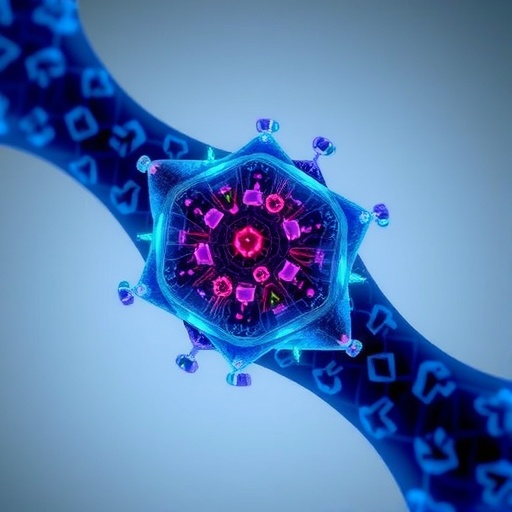In recent years, the convergence of nanotechnology and medical science has opened new avenues for targeted therapy, leading to innovative approaches that hold the promise of revolutionizing cancer treatment. One such groundbreaking development involves the creation of a self-amplifying reactive oxygen species (ROS) nanoplatform designed specifically for tumor-targeted photodynamic therapy. This novel platform, as detailed in a study conducted by Zhou et al., could significantly enhance the efficacy of cancer treatment modalities by utilizing advanced nanotechnology to improve the precision and impact of therapeutic interventions.
The self-amplifying ROS nanoplatform represents a significant evolution in photodynamic therapy, a treatment modality that has traditionally relied on the illumination of photosensitizers to generate ROS in tumor cells. By leveraging a dual-responsiveness mechanism, this nanoplatform not only amplifies the generation of ROS in response to specific stimuli but also ensures targeted delivery to tumor tissues. This innovative strategy is crucial as it minimizes damage to surrounding healthy tissues while maximizing therapeutic effectiveness against malignant cells.
One of the most notable aspects of this research is the dual-responsiveness feature of the nanoplatform. The design integrates two distinct pathways—one that responds to the acidic microenvironment typical of tumor tissues and another that reacts to specific biological markers associated with cancer cells. This strategic approach increases the localization and concentration of ROS production precisely where it is needed most, thereby enhancing the therapeutic window of photodynamic therapy.
The application of ROS as a therapeutic agent is not without its challenges, primarily due to the short-lived nature of these reactive species. However, the self-amplifying aspect of this nanoplatform addresses this limitation effectively. By creating a localized environment that facilitates the continuous generation of ROS, the nanoplatform ensures a sustained therapeutic effect, which could potentially lead to improved clinical outcomes in oncology. This innovative mechanism not only prolongs the exposure of tumor cells to therapeutic ROS but also reduces the likelihood of therapeutic resistance.
Investigators conducted comprehensive in vitro and in vivo studies to validate the efficacy of this self-amplifying ROS nanoplatform. The results demonstrated a remarkable increase in the production of ROS within tumors, leading to significant tumor cell apoptosis. Furthermore, the dual-responsiveness mechanism ensured that healthy tissues remained largely unaffected, highlighting the potential for this therapy to be both effective and safe for patients.
Importantly, the scalability of this self-amplifying nanoplatform means that it can be adapted for various types of cancers. The researchers envision that this technology could be tailored to target specific cancer markers, allowing for personalized treatment plans that take into account the unique biology of a patient’s tumor. This adaptability is a crucial step forward in the ongoing quest for precision medicine in oncology.
Clinical implications of such a platform are profound. The ability to minimize off-target effects while maximizing localized therapeutic action could lead to a paradigm shift in how cancer therapies are developed and administrated. The self-amplifying ROS nanoplatform could serve as a model for future research aimed at integrating nanotechnology with existing treatment modalities, thereby creating multidimensional treatment strategies that leverage multiple mechanisms of action.
Moreover, the potential for combination treatments is immense. The self-amplifying nanoplatform could be integrated with immunotherapies or targeted therapies, facilitating a synergistic approach that further enhances patient responses. Researchers are excited about the implications of this integrated strategy, as it could address multiple pathways involved in tumor growth and metastasis, which are often targeted in contemporary cancer treatments.
Equally vital is the safety profile associated with the use of nanomaterials in medical applications. This study explores the biocompatibility of the nanoplatform in preclinical models. Assessments indicated that the materials used in the construction of the nanoplatform exhibited minimal toxicity, a crucial requirement for any treatment intended for human use. The careful consideration of materials and their interactions with biological systems demonstrates a robust approach to the development of cancer therapies that meet safety and efficacy standards.
The research by Zhou et al. contributes to the broader understanding of how nanomaterials can be engineered for specific therapeutic outcomes. This advancement not only represents a significant step forward in the field of photodynamic therapy but also sets the stage for further innovations in drug delivery systems. As researchers continue to refine these technologies, the potential for improved patient outcomes in cancer treatment becomes increasingly tangible.
Looking ahead, the scientific community is urged to continue exploring the therapeutic applications of self-amplifying systems and nanotechnology in oncology. The promising results outlined in this study are just the starting point for what could evolve into a range of innovative therapies designed to outmaneuver the complexities of cancer. Collaborative efforts among researchers, clinicians, and technology developers may play a pivotal role in bringing these advancements from the laboratory to the clinic.
In conclusion, the self-amplifying ROS nanoplatform represents a remarkable advancement in the field of cancer therapy, merging engineering and medicine to create targeted solutions for elusive malignancies. With ongoing research and development, this platform has the potential to redefine treatment paradigms and enhance the quality of life for cancer patients around the world. The future of oncology may very well be shaped by such innovations that emphasize specificity, safety, and sustaining therapeutic efficacy.
As our understanding of tumor microenvironments and the interactions of nanomaterials with biological systems continues to expand, we must embrace a future where engineering innovation can provide groundbreaking solutions to the most pressing health challenges faced by humanity. The pathway to improved cancer therapies is paved with innovations like the self-amplifying ROS nanoplatform, fostering hope in the battle against cancer for patients and healthcare professionals alike.
Subject of Research: Self-amplifying ROS nanoplatform for tumor-targeted photodynamic therapy
Article Title: Self-amplifying ROS nanoplatform with dual responsiveness for tumor-targeted photodynamic therapy
Article References:
Zhou, Y., Wang, Z., Tong, N. et al. Self-amplifying ROS nanoplatform with dual responsiveness for tumor-targeted photodynamic therapy.
J. Pharm. Investig. (2025). https://doi.org/10.1007/s40005-025-00772-4
Image Credits: AI Generated
DOI: 10.1007/s40005-025-00772-4
Keywords: Nanotechnology, Photodynamic therapy, Reactive oxygen species, Cancer treatment, Targeted therapy, Dual responsiveness, Tumor microenvironment, Drug delivery systems, Precision medicine, Biocompatibility.




